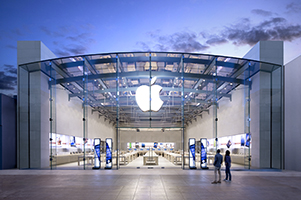The Apple of the Mind’s Eye
 With its simple design, the Apple Inc. logo is one of the most recognizable emblems in the world. But how well do people remember details of the icon? Which way does the leaf point? Is the bitten section on the right or left side?
With its simple design, the Apple Inc. logo is one of the most recognizable emblems in the world. But how well do people remember details of the icon? Which way does the leaf point? Is the bitten section on the right or left side?
Psychological scientists at the University of California, Los Angeles (UCLA), under the leadership of Alan D. Castel, examined participants’ recall for these details on the ubiquitous logo, and the degree to which metamemory (i.e., confidence judgments) match memory performance.
The study borrows from a classic study that showed that people often have difficulty recognizing the correct locations of features on a US penny. That 1979 study by APS Fellow Raymond Nickerson and Marilyn Jager Adams demonstrated that people have a poor memory for items they see regularly.
To test memory for the Apple logo, the UCLA scientists gave 85 undergraduate students blank sheets of paper and asked them to draw the Apple logo from memory, then rate the accuracy of their drawing on a 10-point scale, with 10 indicating extremely high confidence.
The researchers then presented the volunteers with the real logo along with a number of similar but slightly altered icons. One of the images, for example, had the leaf leaning to the left, while another had the bite on the left. (The actual logo has a right-leaning leaf and the bite on the right side.) The participants were tasked with choosing the actual Apple logo from the various images and rating their confidence in their choice.
Lastly, the participants completed a questionnaire asking how often they used Apple products, if they liked Apple products, and whether they identified themselves as primarily Apple users, PC users, or users of both. The group included 52 self-proclaimed Apple users, 10 PC users, and 23 students who used both types of products.
Although the participants generally rated their confidence in the accuracy of their drawings fairly highly, only one student accurately reproduced the logo, and just seven were able to draw it with minimal errors. Also, fewer than half of the students correctly identified the real logo from the group of apple-shaped icons they were shown.
In a second experiment, 26 students were asked to rate how confident they were in their ability to accurately replicate the logo both before they drew it and afterward. Most reported feeling very confident in their ability to make an accurate drawing, but lost a significant amount of confidence after actually completing a drawing.
The researchers suggested that “engaging in the recall task appeared to generate awareness of the difficulty in recalling the features.”
“Increased exposure increases familiarity and confidence, but does not reliably affect memory,” the authors concluded. “Despite frequent exposure to a simple and visually pleasing logo, attention and memory are not always tuned to remembering what we may think is memorable.”
Reference
Blake, A. B., Nazarian, M., & Castel, A. D. (2015). The apple of the mind’s eye: Everyday attention, metamemory, and reconstructive memory of the Apple logo. The Quarterly Journal of Experimental Psychology, 68, 858–865.




Comments
Why do we need to remember the logo. Only recognition is required?
APS regularly opens certain online articles for discussion on our website. Effective February 2021, you must be a logged-in APS member to post comments. By posting a comment, you agree to our Community Guidelines and the display of your profile information, including your name and affiliation. Any opinions, findings, conclusions, or recommendations present in article comments are those of the writers and do not necessarily reflect the views of APS or the article’s author. For more information, please see our Community Guidelines.
Please login with your APS account to comment.